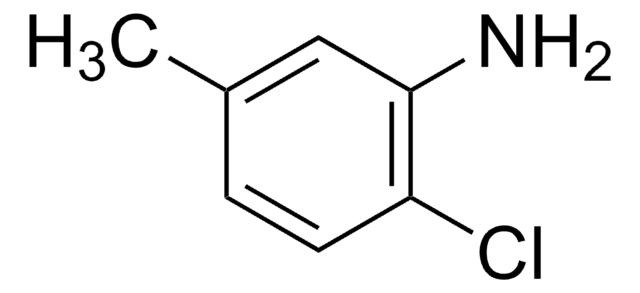Wichtige Dokumente
102253
2,5-Dimethylanilin
99%
Synonym(e):
2,5-Xylidin, 2-Amino-1,4-dimethyl-benzol, 2-Amino-p-xylol
Größe auswählen
About This Item
Empfohlene Produkte
Assay
99%
Brechungsindex
n20/D 1.559 (lit.)
bp
218 °C (lit.)
mp (Schmelzpunkt)
11.5 °C (lit.)
Dichte
0.973 g/mL at 25 °C (lit.)
SMILES String
Cc1ccc(C)c(N)c1
InChI
1S/C8H11N/c1-6-3-4-7(2)8(9)5-6/h3-5H,9H2,1-2H3
InChIKey
VOWZNBNDMFLQGM-UHFFFAOYSA-N
Suchen Sie nach ähnlichen Produkten? Aufrufen Leitfaden zum Produktvergleich
Verwandte Kategorien
Allgemeine Beschreibung
Signalwort
Danger
H-Sätze
Gefahreneinstufungen
Acute Tox. 3 Dermal - Acute Tox. 3 Inhalation - Acute Tox. 3 Oral - Aquatic Chronic 2 - STOT RE 2
Lagerklassenschlüssel
6.1A - Combustible acute toxic Cat. 1 and 2 / very toxic hazardous materials
WGK
WGK 3
Flammpunkt (°F)
204.8 °F - closed cup
Flammpunkt (°C)
96 °C - closed cup
Persönliche Schutzausrüstung
Eyeshields, Faceshields, Gloves, type ABEK (EN14387) respirator filter
Hier finden Sie alle aktuellen Versionen:
Besitzen Sie dieses Produkt bereits?
In der Dokumentenbibliothek finden Sie die Dokumentation zu den Produkten, die Sie kürzlich erworben haben.
Kunden haben sich ebenfalls angesehen
Active Filters
Unser Team von Wissenschaftlern verfügt über Erfahrung in allen Forschungsbereichen einschließlich Life Science, Materialwissenschaften, chemischer Synthese, Chromatographie, Analytik und vielen mehr..
Setzen Sie sich mit dem technischen Dienst in Verbindung.

















